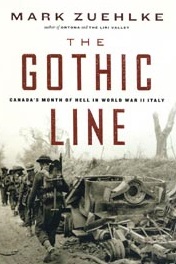 This information has been archived for reference or research purposes.
This information has been archived for reference or research purposes.
Archived Content
Information identified as archived on the Web is for reference, research or recordkeeping purposes. It has not been altered or updated after the date of archiving. Web pages that are archived on the Web are not subject to the Government of Canada Web Standards. As per the Communications Policy of the Government of Canada, you can request alternate formats on the "Contact Us" page.
Book Reviews
The Gothic Line: Canada’s Month of Hell in World War II Italy
by Mark Zuehlke
Vancouver: Douglas & McIntyre. 551 pages, $45.00
Reviewed by Major Michael Boire
For more information on accessing this file, please visit our help page.
 This
is the final book in Mark Zuehlke’s masterful trilogy on the Canadian Army in
the Italian Campaign. The first volume vividly portrayed the 1st Canadian Infantry
Division’s long and bloody fight for Ortona s in December 1943. The second gave
us a remarkable insight into I Canadian Corp’s baptism of fire in the Liri Valley
the following June. This last book tells the story of what was the Canadian Army’s
crowning achievement of the campaign — the breaking of the Gothic Line in August
and September 1944.
This
is the final book in Mark Zuehlke’s masterful trilogy on the Canadian Army in
the Italian Campaign. The first volume vividly portrayed the 1st Canadian Infantry
Division’s long and bloody fight for Ortona s in December 1943. The second gave
us a remarkable insight into I Canadian Corp’s baptism of fire in the Liri Valley
the following June. This last book tells the story of what was the Canadian Army’s
crowning achievement of the campaign — the breaking of the Gothic Line in August
and September 1944.
Zuehlke has written a riveting story about Canadians in battle, organizing veterans’ recollections of the campaign to tell us what it was like to fight a determined enemy across the valleys and mountains of Italy. In one of the most stirring accounts, Syd Frost, a platoon commander in the PPCLI, recounts that he “bent down to speak to one of his wounded men just as an armour-piercing round ripped through the wall where his head had been moments before and exited out the rear wall in a flash of sparks. Everyone flattened on the floor as another AP round flashed through the room. A Nebelwerfer stonk fell on the house and chunks of the ceiling collapsed, with only some strong beams overhead providing any protection. Smoke and dust filled the room. One man started sobbing hysterically. More holes were punched into the walls by AP rounds. It seemed impossible that the shattered structure could stand any more damage.”
Untangling the often-conflicting information contained in soldiers’ personal recollections, as well as in official documents such as unit war diaries and after-action reports, remains a daunting task for any researcher. Once again, Zuehlke has carried it off, successfully incorporating both types of sources, and in his own words “shaping a detailed narrative of the Canadian experience of battle by weaving together the accounts of veterans and the official record.” This is indeed a soldier’s-eye-view of battle that will be appreciated by serious students of Canada’s military history who want to know what fighting was like.
In order to keep the reader oriented, Zuehlke anchors his descriptions of battalion, company, and platoon actions firmly within the phases of the Gothic Line operation, as they are recounted in the Canadian official history of the campaign. Of particular interest to the novice reader are the 1st Division’s assaults on the Metauro and Arzilla River lines as well as the 5th Armoured Division’s battle on and beyond the Foglia River. Those students with some background in Canada’s military history will appreciate another glimpse into relationships between the key players in the Gothic Line drama: Generals Leese, Burns, Vokes and Hoffmeister. This book is as user-friendly as its predecessors. Readers unfamiliar with military organizations, terms, weaponry, ranks or decorations can consult the appendices at the back. While the maps are adequate, smallerscale depictions of unit actions would have reinforced the strength of the narrative.
In just four years, Mark Zuehlke has produced three first-rate volumes of lively and accessible prose treating the Canadian Army in the Italian campaign. This is an impressive contribution to Canadian military historiography, where the gaze continues to be fixed on the European Theatre in the Second World War. Indeed, Mark Zuehlke has been a D-Day Dodger and we are better informed for it.
Major Shane Schreiber is Editor of The Army Doctrine and Training Bulletin.






